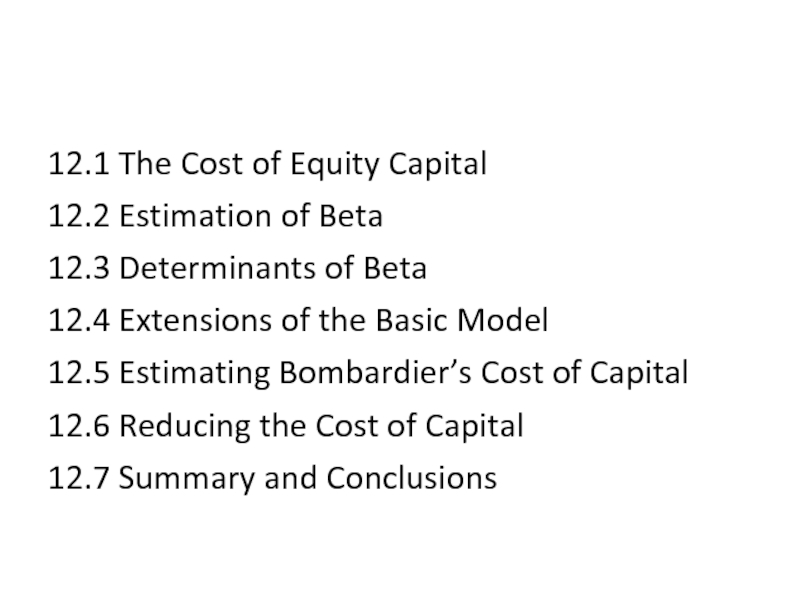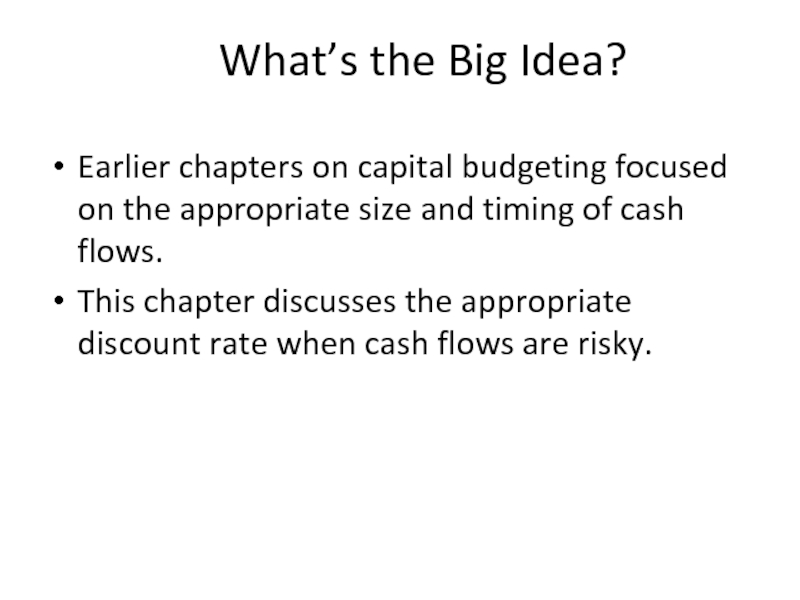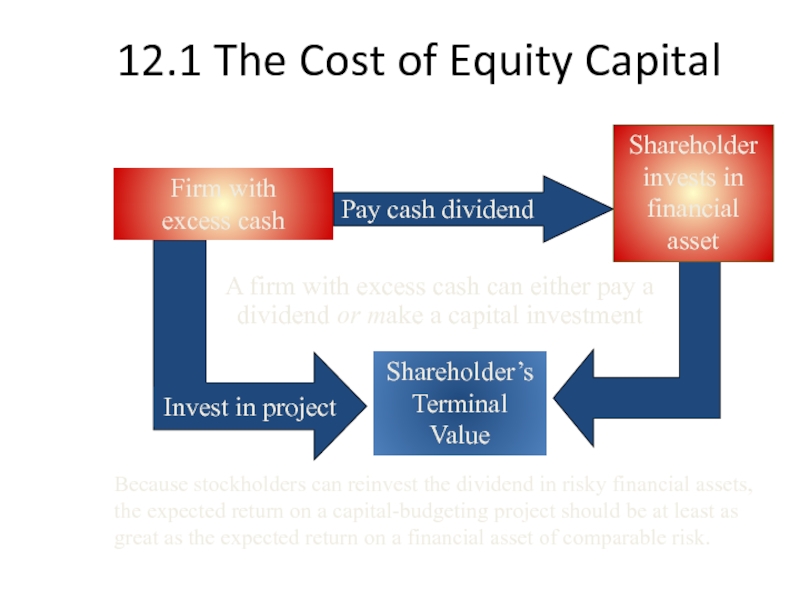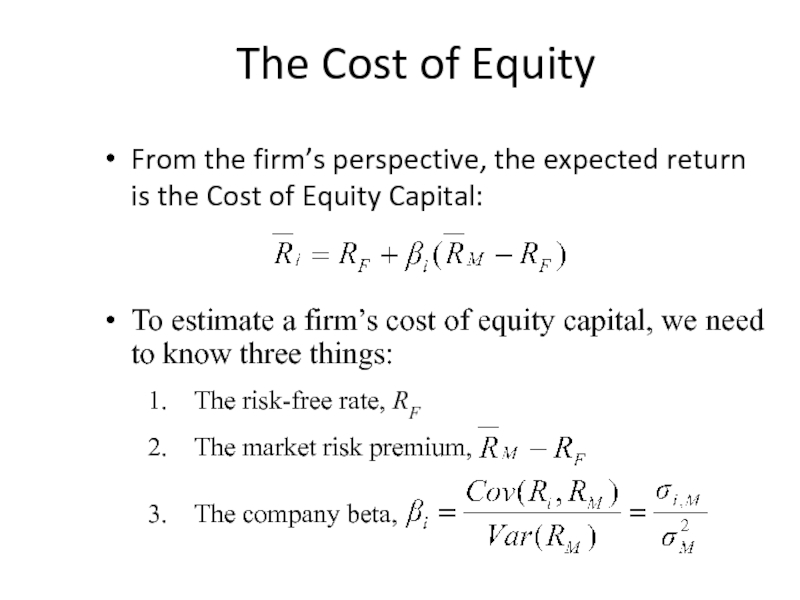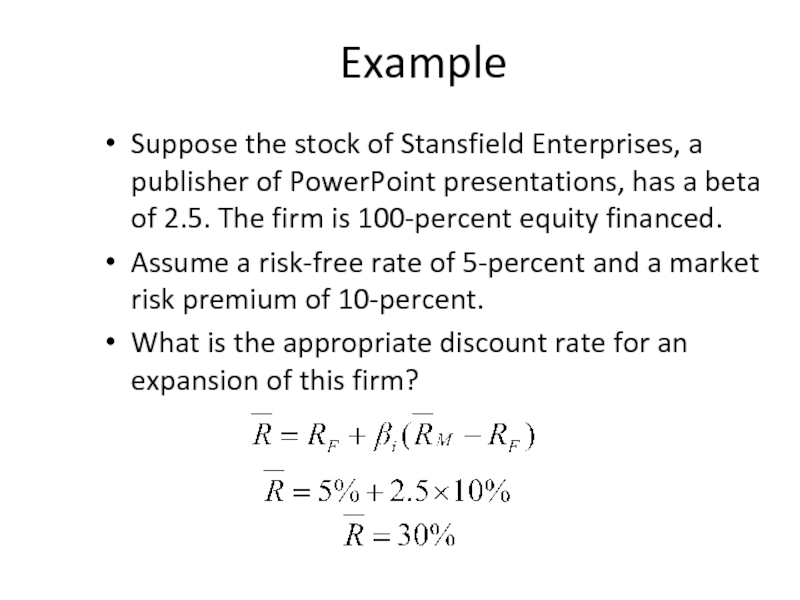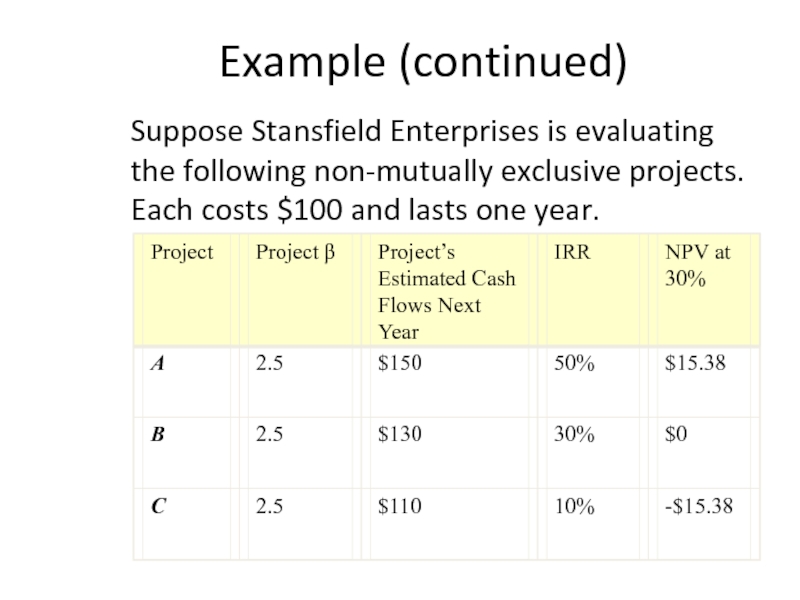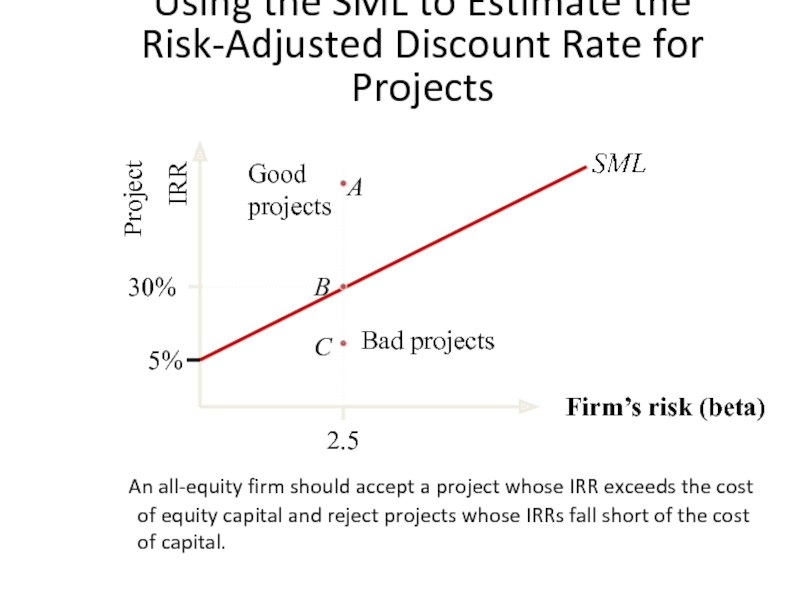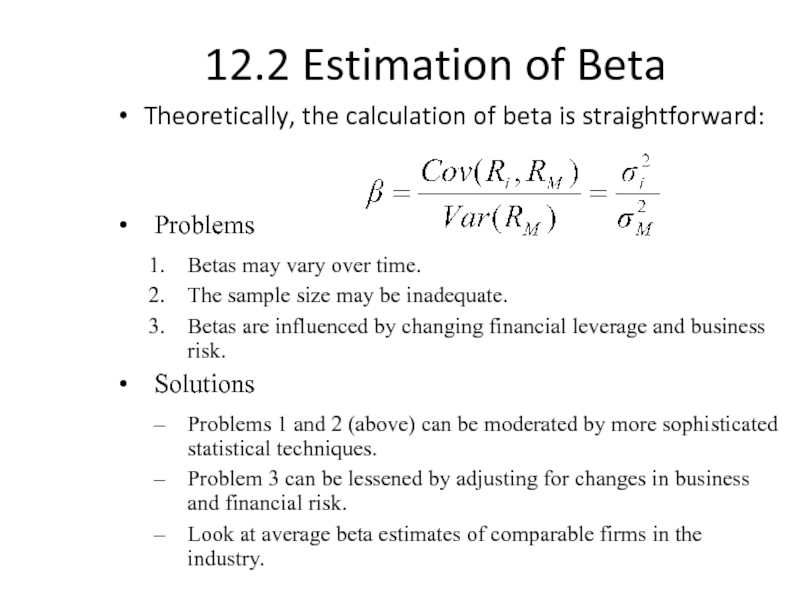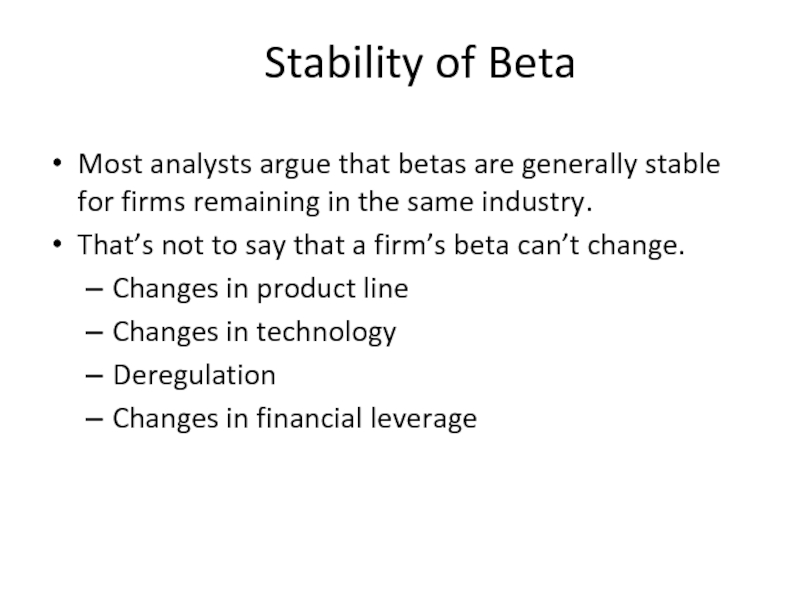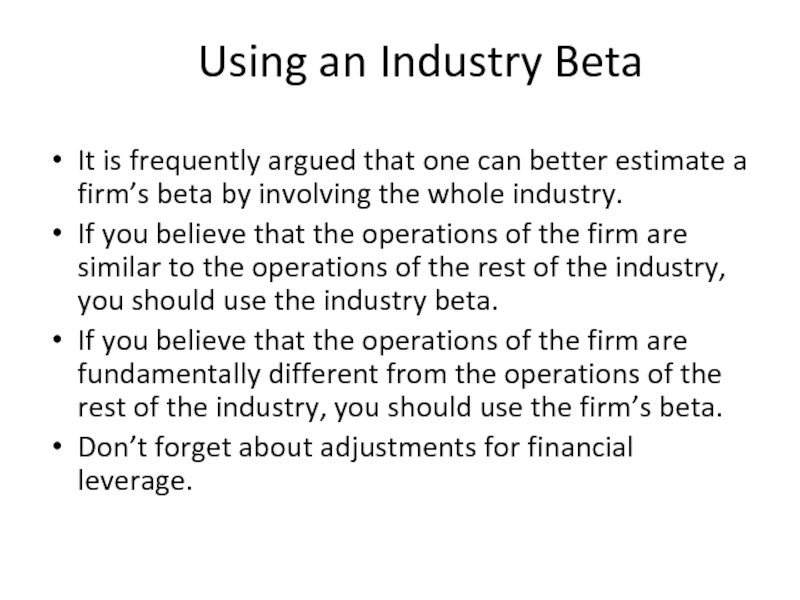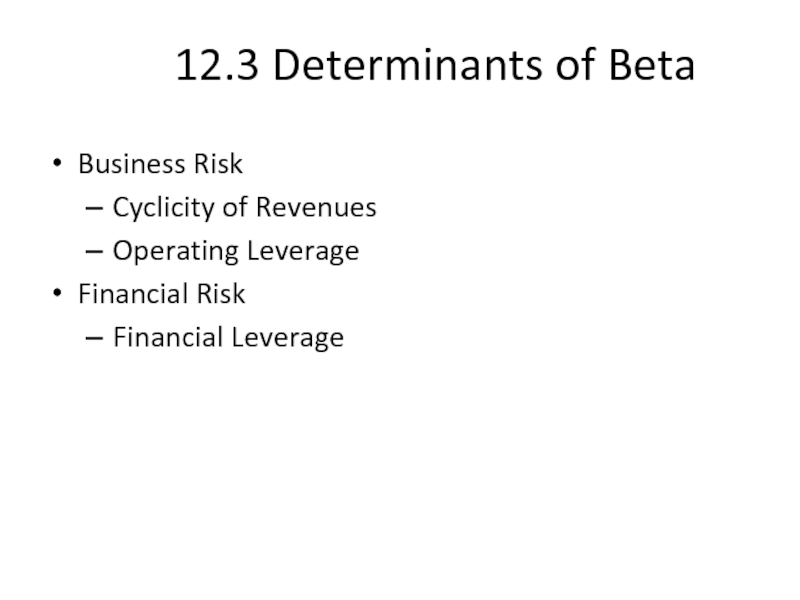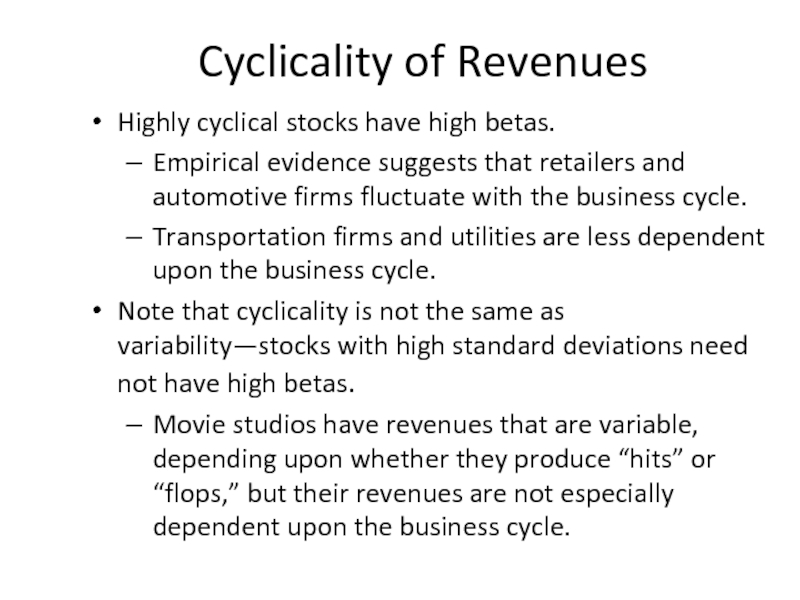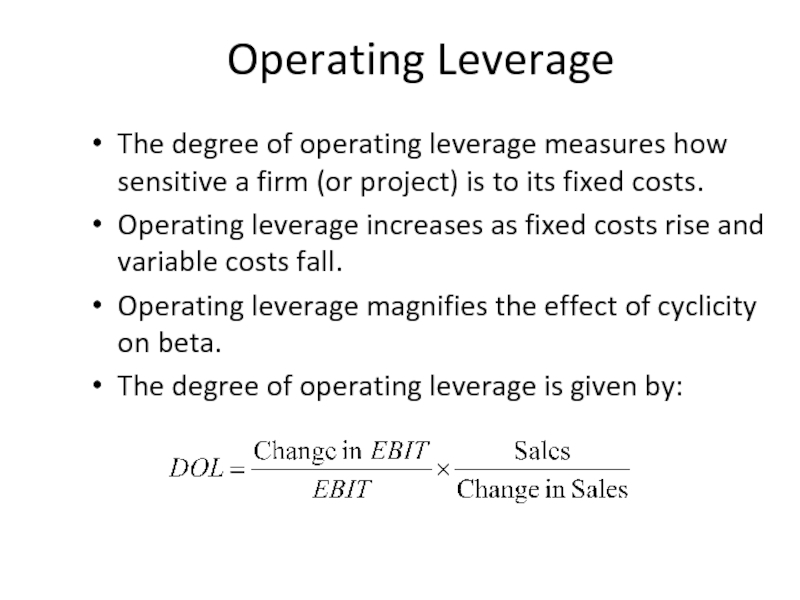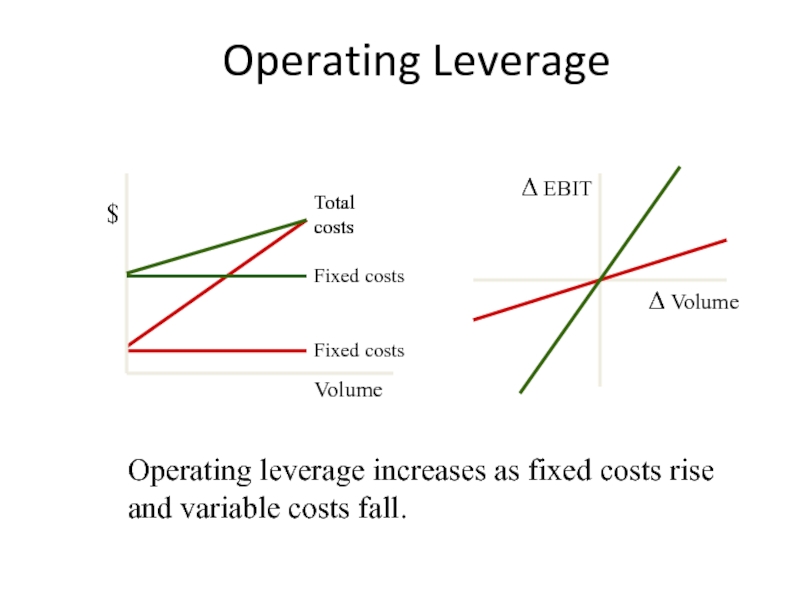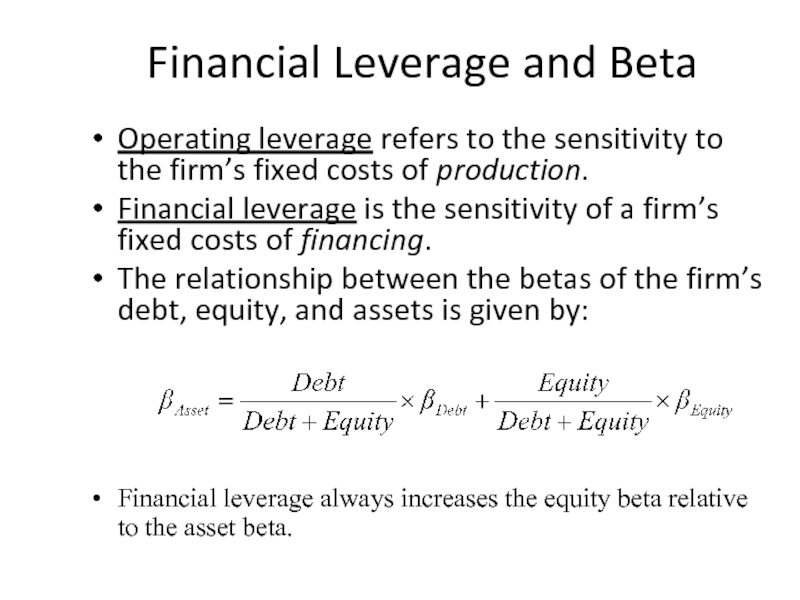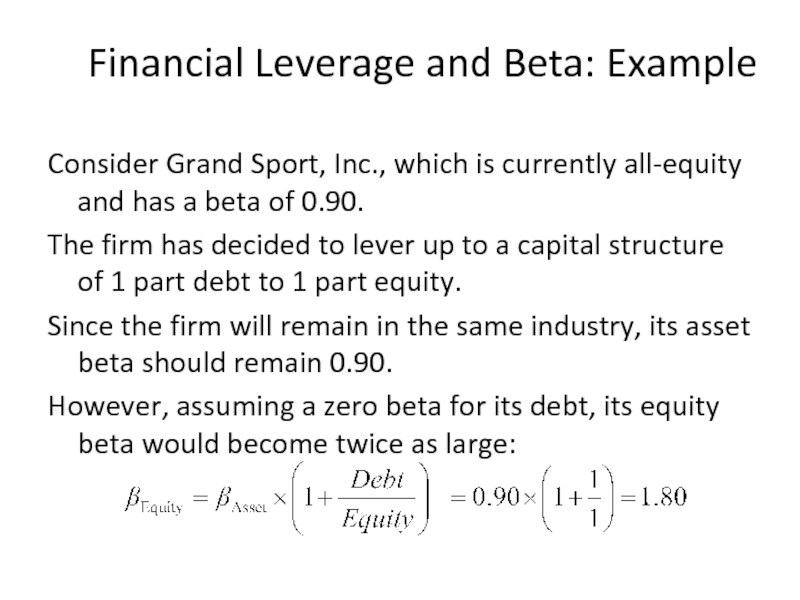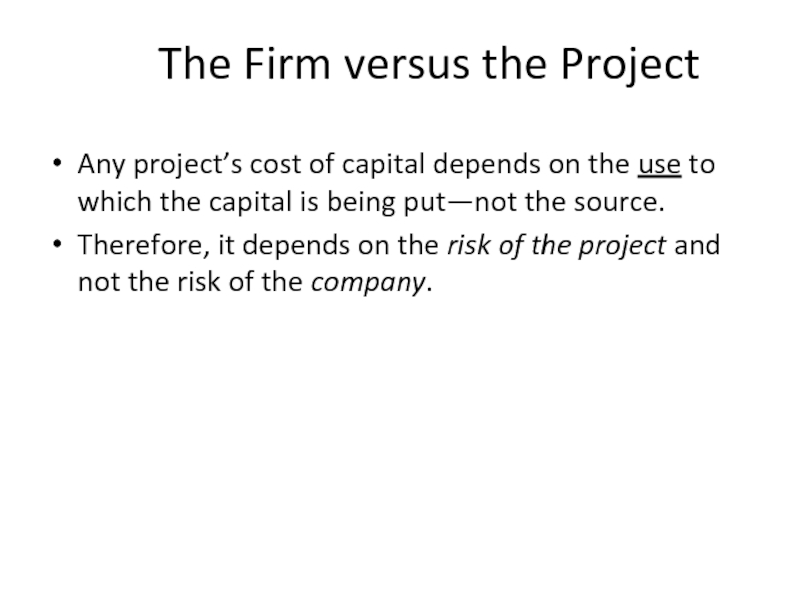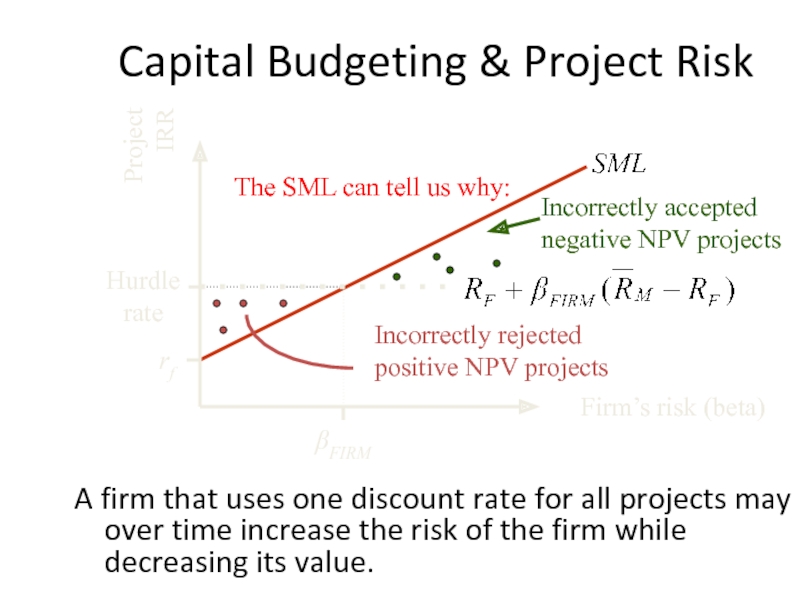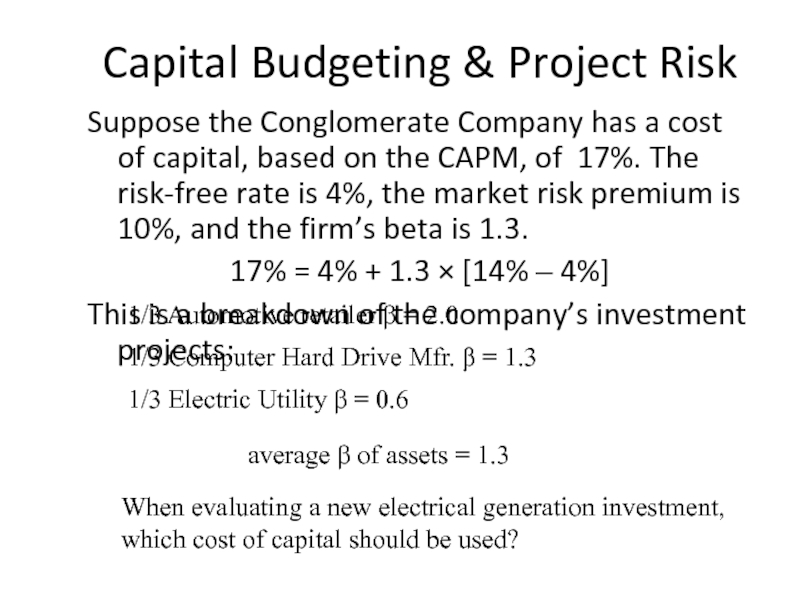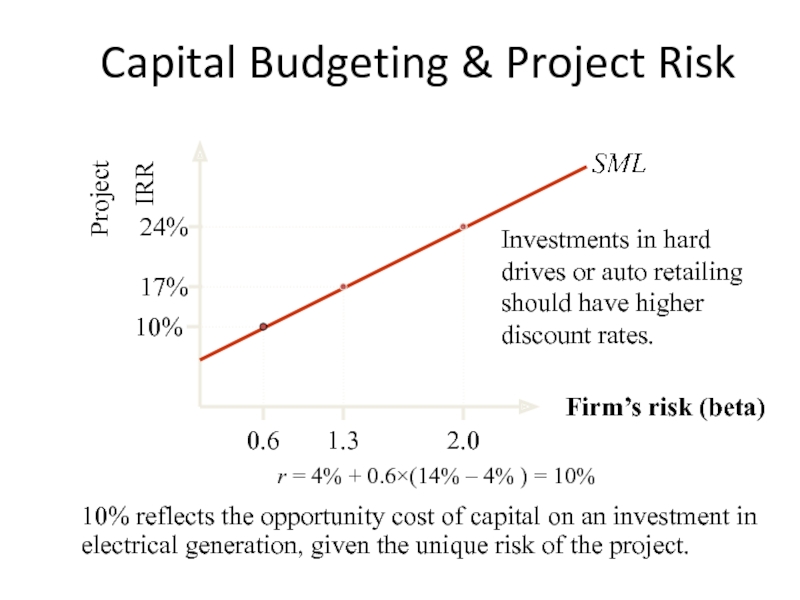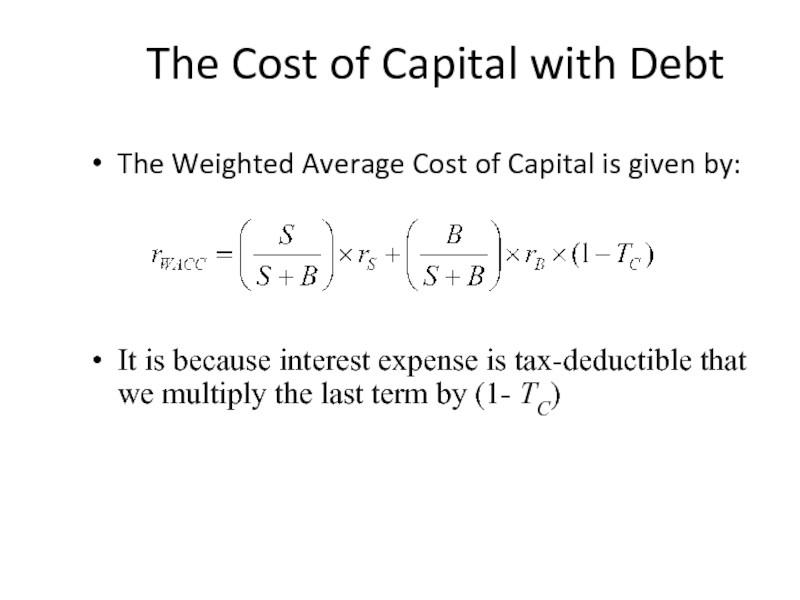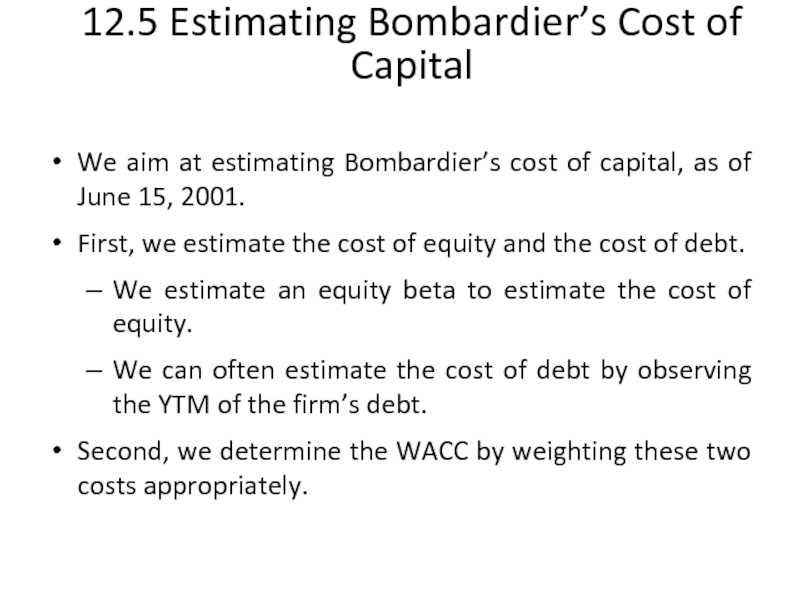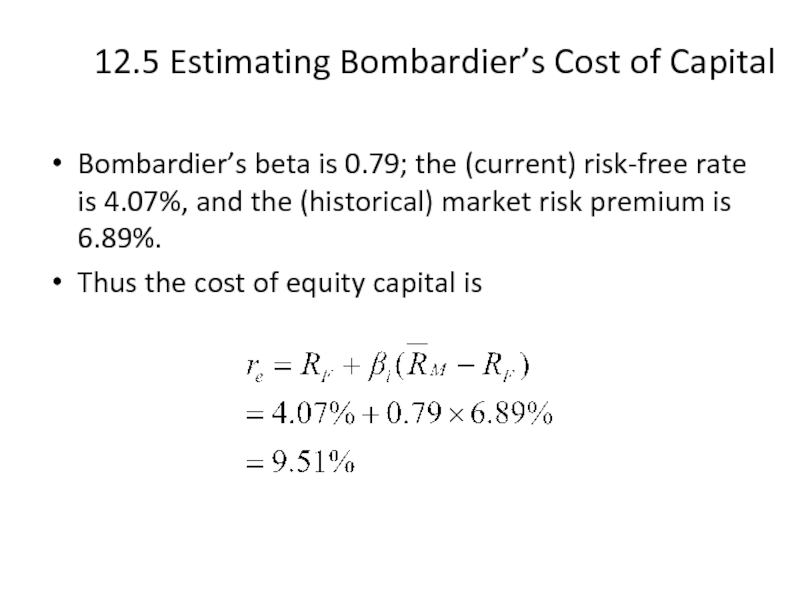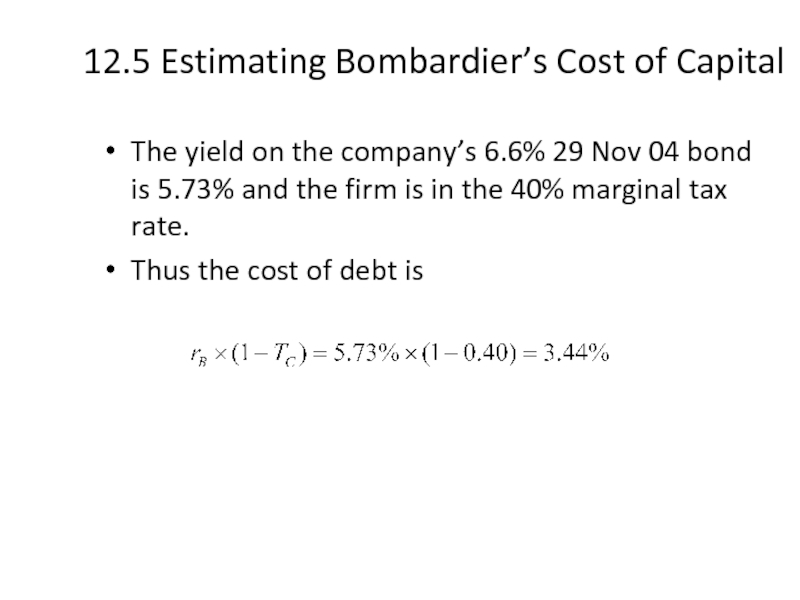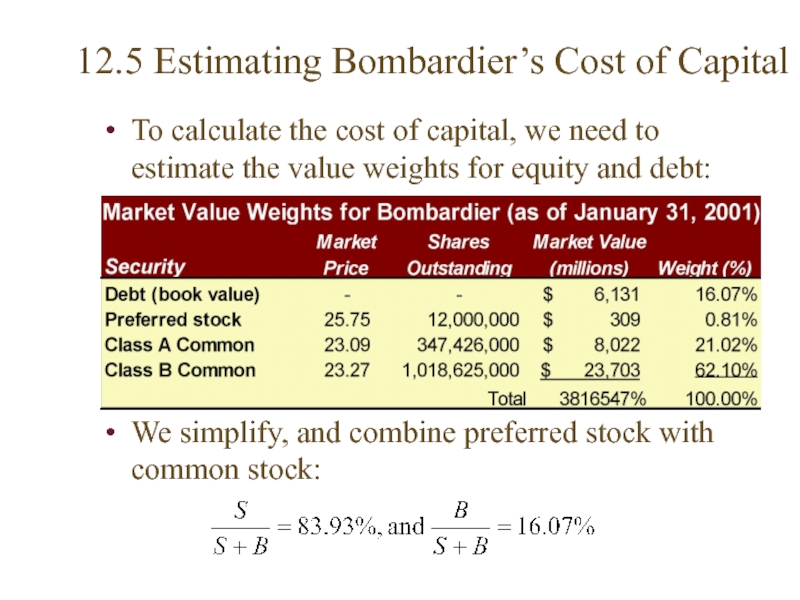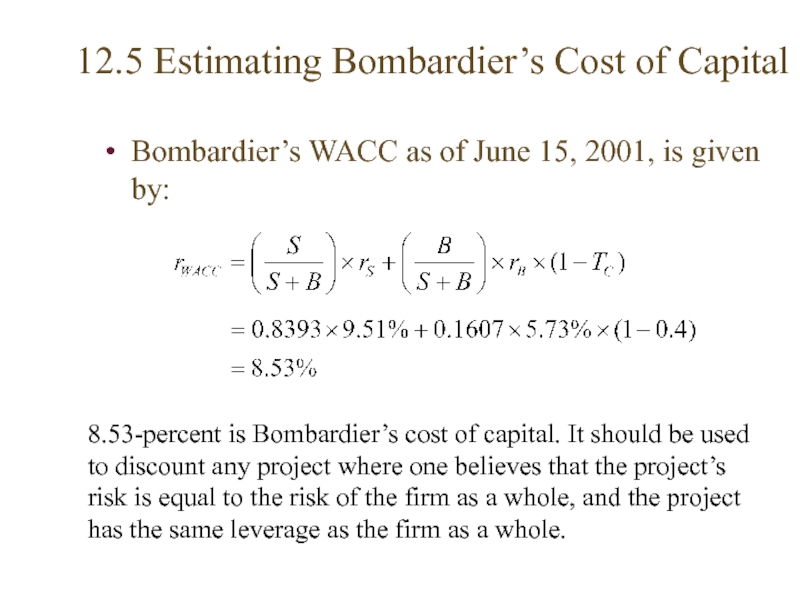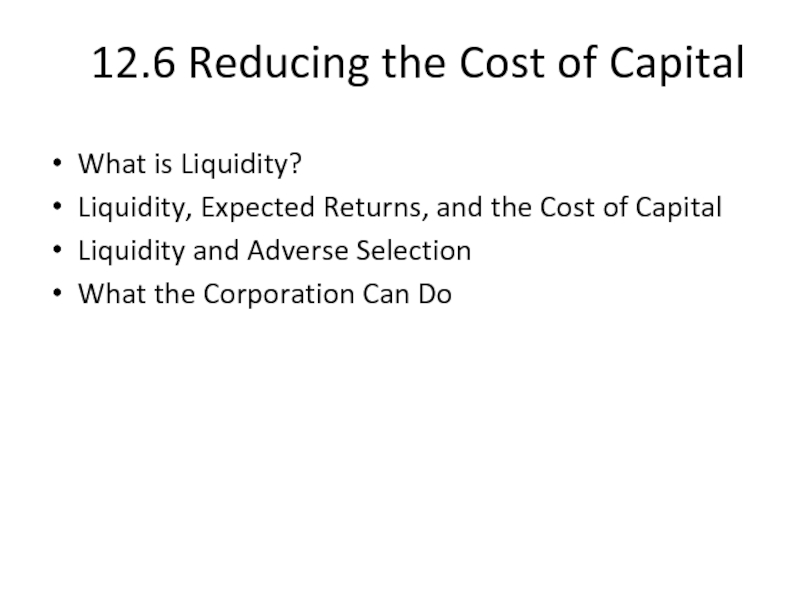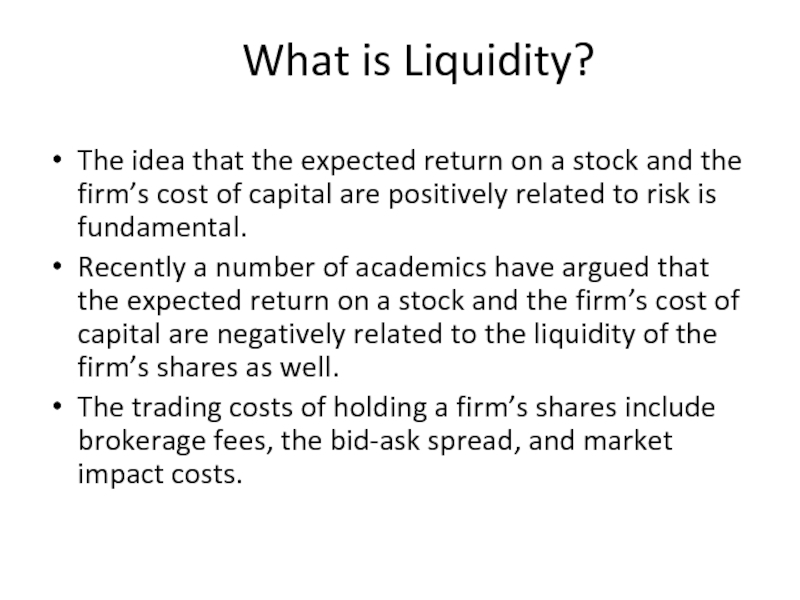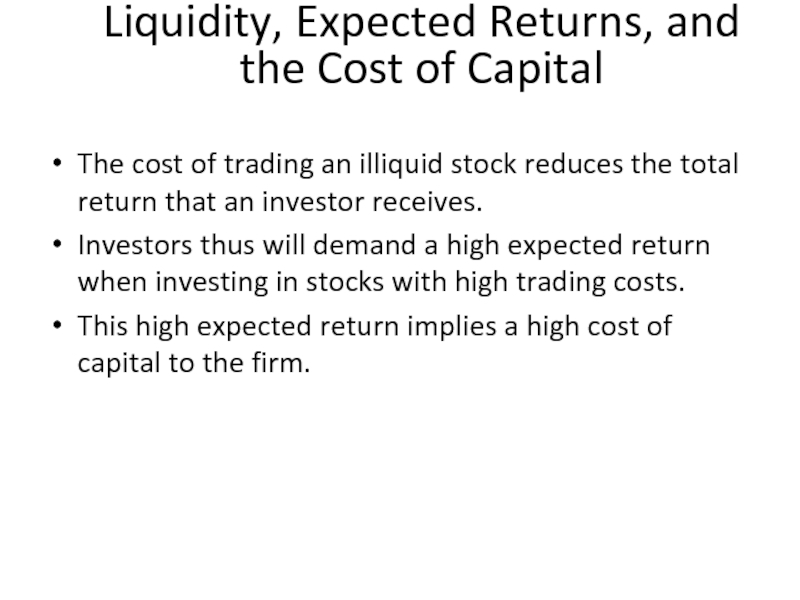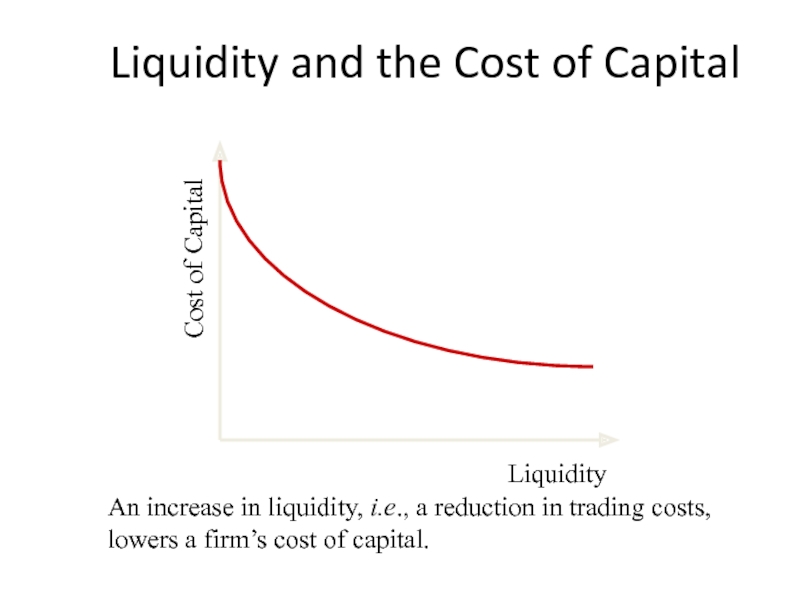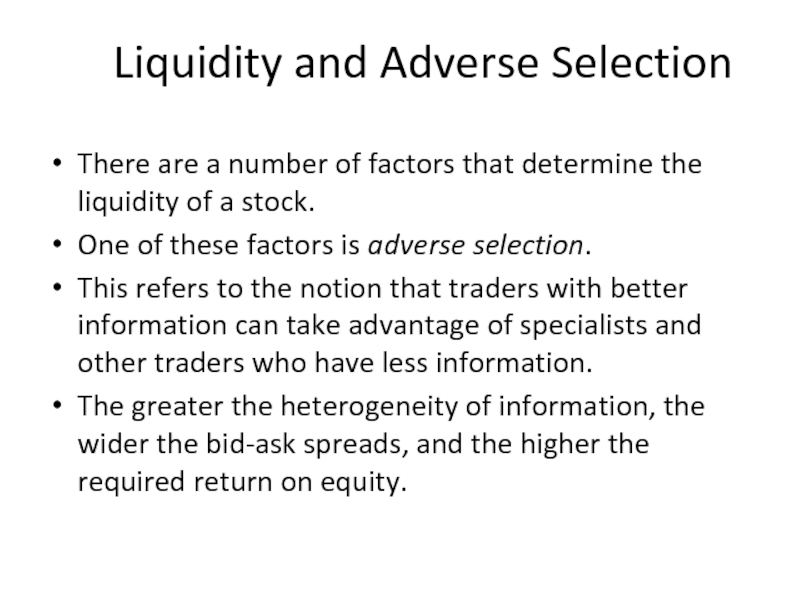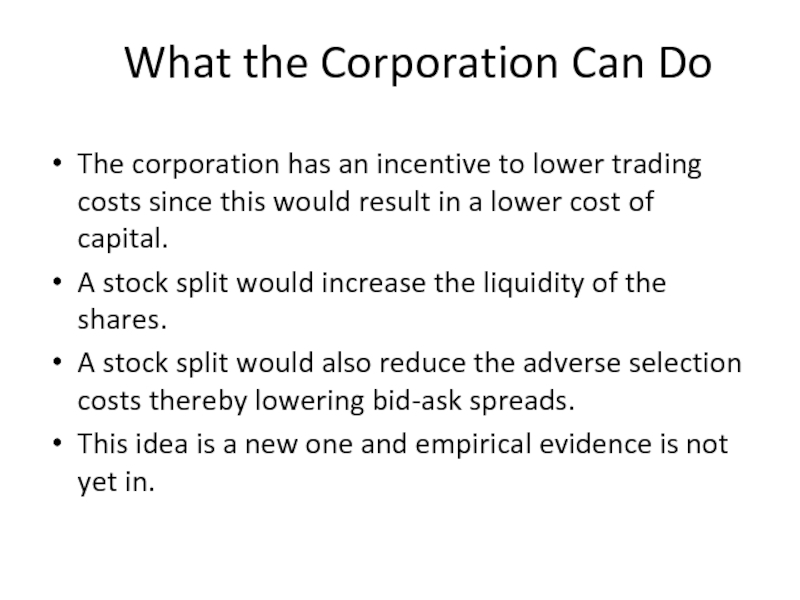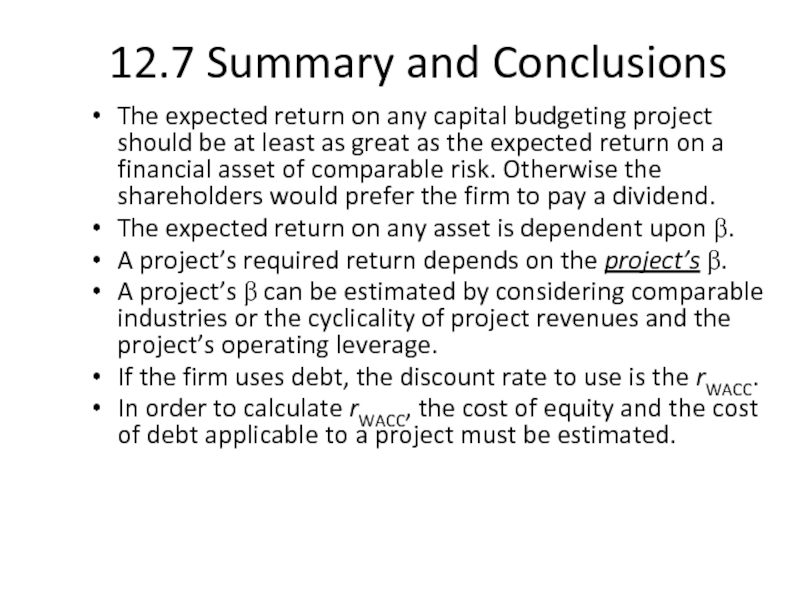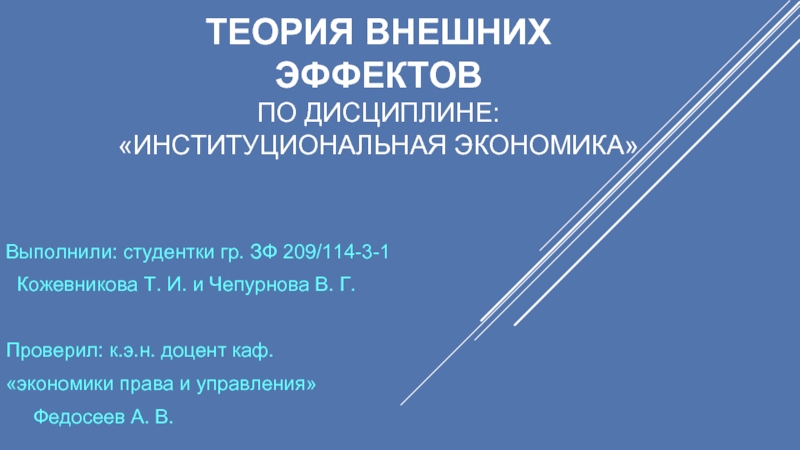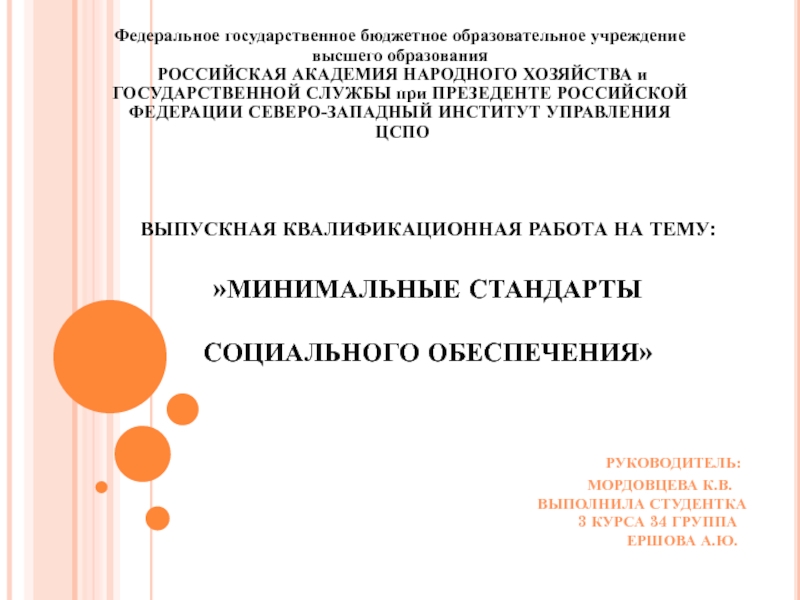- Главная
- Разное
- Дизайн
- Бизнес и предпринимательство
- Аналитика
- Образование
- Развлечения
- Красота и здоровье
- Финансы
- Государство
- Путешествия
- Спорт
- Недвижимость
- Армия
- Графика
- Культурология
- Еда и кулинария
- Лингвистика
- Английский язык
- Астрономия
- Алгебра
- Биология
- География
- Детские презентации
- Информатика
- История
- Литература
- Маркетинг
- Математика
- Медицина
- Менеджмент
- Музыка
- МХК
- Немецкий язык
- ОБЖ
- Обществознание
- Окружающий мир
- Педагогика
- Русский язык
- Технология
- Физика
- Философия
- Химия
- Шаблоны, картинки для презентаций
- Экология
- Экономика
- Юриспруденция
Risk Return and Project Decisions презентация
Содержание
- 1. Risk Return and Project Decisions
- 2. What’s the Big Idea? Earlier chapters on
- 3. 12.1 The Cost of Equity Capital
- 4. The Cost of Equity From the firm’s
- 5. Example Suppose the stock of Stansfield Enterprises,
- 6. Example (continued) Suppose Stansfield Enterprises
- 7. Using the SML to Estimate the Risk-Adjusted
- 8. 12.2 Estimation of Beta: Measuring
- 9. 12.2 Estimation of Beta Theoretically, the calculation
- 10. Stability of Beta Most analysts argue that
- 11. Using an Industry Beta It is frequently
- 12. 12.3 Determinants of Beta Business Risk Cyclicity of Revenues Operating Leverage Financial Risk Financial Leverage
- 13. Cyclicality of Revenues Highly cyclical stocks have
- 14. Operating Leverage The degree of operating leverage
- 15. Operating Leverage Volume $ Fixed costs Total
- 16. Financial Leverage and Beta Operating leverage refers
- 17. Financial Leverage and Beta: Example Consider Grand
- 18. 12.4 Extensions of the Basic Model The
- 19. The Firm versus the Project
- 20. Capital Budgeting & Project Risk A firm
- 21. Capital Budgeting & Project Risk Suppose the
- 22. Capital Budgeting & Project Risk Project
- 23. The Cost of Capital with Debt The
- 24. 12.5 Estimating Bombardier’s Cost of Capital We
- 25. 12.5 Estimating Bombardier’s Cost of Capital Bombardier’s
- 26. 12.5 Estimating Bombardier’s Cost of Capital The
- 27. 12.5 Estimating Bombardier’s Cost of Capital To
- 28. 12.5 Estimating Bombardier’s Cost of Capital Bombardier’s
- 29. 12.6 Reducing the Cost of Capital What
- 30. What is Liquidity? The idea that the
- 31. Liquidity, Expected Returns, and the Cost of
- 32. Liquidity and the Cost of Capital Cost
- 33. Liquidity and Adverse Selection There are a
- 34. What the Corporation Can Do The corporation
- 35. What the Corporation Can Do Companies can
- 36. 12.7 Summary and Conclusions The expected return
Слайд 112.1 The Cost of Equity Capital
12.2 Estimation of Beta
12.3 Determinants of
12.4 Extensions of the Basic Model
12.5 Estimating Bombardier’s Cost of Capital
12.6 Reducing the Cost of Capital
12.7 Summary and Conclusions
Слайд 2What’s the Big Idea?
Earlier chapters on capital budgeting focused on the
This chapter discusses the appropriate discount rate when cash flows are risky.
Слайд 3
12.1 The Cost of Equity Capital
Firm with
excess cash
Shareholder’s Terminal Value
Shareholder invests
Because stockholders can reinvest the dividend in risky financial assets, the expected return on a capital-budgeting project should be at least as great as the expected return on a financial asset of comparable risk.
A firm with excess cash can either pay a dividend or make a capital investment
Слайд 4The Cost of Equity
From the firm’s perspective, the expected return is
To estimate a firm’s cost of equity capital, we need to know three things:
The risk-free rate, RF
Слайд 5Example
Suppose the stock of Stansfield Enterprises, a publisher of PowerPoint presentations,
Assume a risk-free rate of 5-percent and a market risk premium of 10-percent.
What is the appropriate discount rate for an expansion of this firm?
Слайд 6Example (continued)
Suppose Stansfield Enterprises is evaluating the following non-mutually
Слайд 7Using the SML to Estimate the Risk-Adjusted Discount Rate for Projects
Project
IRR
Firm’s risk (beta)
5%
Good projects
Bad projects
Слайд 8
12.2 Estimation of Beta: Measuring Market Risk
Market Portfolio - Portfolio of
Beta - Sensitivity of a stock’s return to the return on the market portfolio.
Слайд 912.2 Estimation of Beta
Theoretically, the calculation of beta is straightforward:
Problems
Betas may
The sample size may be inadequate.
Betas are influenced by changing financial leverage and business risk.
Solutions
Problems 1 and 2 (above) can be moderated by more sophisticated statistical techniques.
Problem 3 can be lessened by adjusting for changes in business and financial risk.
Look at average beta estimates of comparable firms in the industry.
Слайд 10Stability of Beta
Most analysts argue that betas are generally stable for
That’s not to say that a firm’s beta can’t change.
Changes in product line
Changes in technology
Deregulation
Changes in financial leverage
Слайд 11Using an Industry Beta
It is frequently argued that one can better
If you believe that the operations of the firm are similar to the operations of the rest of the industry, you should use the industry beta.
If you believe that the operations of the firm are fundamentally different from the operations of the rest of the industry, you should use the firm’s beta.
Don’t forget about adjustments for financial leverage.
Слайд 1212.3 Determinants of Beta
Business Risk
Cyclicity of Revenues
Operating Leverage
Financial Risk
Financial Leverage
Слайд 13Cyclicality of Revenues
Highly cyclical stocks have high betas.
Empirical evidence suggests that
Transportation firms and utilities are less dependent upon the business cycle.
Note that cyclicality is not the same as variability—stocks with high standard deviations need not have high betas.
Movie studios have revenues that are variable, depending upon whether they produce “hits” or “flops,” but their revenues are not especially dependent upon the business cycle.
Слайд 14Operating Leverage
The degree of operating leverage measures how sensitive a firm
Operating leverage increases as fixed costs rise and variable costs fall.
Operating leverage magnifies the effect of cyclicity on beta.
The degree of operating leverage is given by:
Слайд 15Operating Leverage
Volume
$
Fixed costs
Total costs
Δ EBIT
Δ Volume
Operating leverage increases as fixed costs
Слайд 16Financial Leverage and Beta
Operating leverage refers to the sensitivity to the
Financial leverage is the sensitivity of a firm’s fixed costs of financing.
The relationship between the betas of the firm’s debt, equity, and assets is given by:
Financial leverage always increases the equity beta relative to the asset beta.
Слайд 17Financial Leverage and Beta: Example
Consider Grand Sport, Inc., which is currently
The firm has decided to lever up to a capital structure of 1 part debt to 1 part equity.
Since the firm will remain in the same industry, its asset beta should remain 0.90.
However, assuming a zero beta for its debt, its equity beta would become twice as large:
Слайд 19
The Firm versus the Project
Any project’s cost of capital depends on
Therefore, it depends on the risk of the project and not the risk of the company.
Слайд 20Capital Budgeting & Project Risk
A firm that uses one discount rate
Project IRR
Firm’s risk (beta)
Hurdle rate
The SML can tell us why:
Слайд 21Capital Budgeting & Project Risk
Suppose the Conglomerate Company has a cost
17% = 4% + 1.3 × [14% – 4%]
This is a breakdown of the company’s investment projects:
1/3 Automotive retailer β = 2.0
1/3 Computer Hard Drive Mfr. β = 1.3
1/3 Electric Utility β = 0.6
average β of assets = 1.3
When evaluating a new electrical generation investment, which cost of capital should be used?
Слайд 22Capital Budgeting & Project Risk
Project
IRR
Firm’s risk (beta)
r = 4% +
10% reflects the opportunity cost of capital on an investment in electrical generation, given the unique risk of the project.
Investments in hard drives or auto retailing should have higher discount rates.
Слайд 23The Cost of Capital with Debt
The Weighted Average Cost of Capital
It is because interest expense is tax-deductible that we multiply the last term by (1- TC)
Слайд 2412.5 Estimating Bombardier’s Cost of Capital
We aim at estimating Bombardier’s cost
First, we estimate the cost of equity and the cost of debt.
We estimate an equity beta to estimate the cost of equity.
We can often estimate the cost of debt by observing the YTM of the firm’s debt.
Second, we determine the WACC by weighting these two costs appropriately.
Слайд 2512.5 Estimating Bombardier’s Cost of Capital
Bombardier’s beta is 0.79; the (current)
Thus the cost of equity capital is
Слайд 2612.5 Estimating Bombardier’s Cost of Capital
The yield on the company’s 6.6%
Thus the cost of debt is
Слайд 2712.5 Estimating Bombardier’s Cost of Capital
To calculate the cost of capital,
We simplify, and combine preferred stock with common stock:
Слайд 2812.5 Estimating Bombardier’s Cost of Capital
Bombardier’s WACC as of June 15,
8.53-percent is Bombardier’s cost of capital. It should be used to discount any project where one believes that the project’s risk is equal to the risk of the firm as a whole, and the project has the same leverage as the firm as a whole.
Слайд 2912.6 Reducing the Cost of Capital
What is Liquidity?
Liquidity, Expected Returns, and
Liquidity and Adverse Selection
What the Corporation Can Do
Слайд 30What is Liquidity?
The idea that the expected return on a stock
Recently a number of academics have argued that the expected return on a stock and the firm’s cost of capital are negatively related to the liquidity of the firm’s shares as well.
The trading costs of holding a firm’s shares include brokerage fees, the bid-ask spread, and market impact costs.
Слайд 31Liquidity, Expected Returns, and the Cost of Capital
The cost of trading
Investors thus will demand a high expected return when investing in stocks with high trading costs.
This high expected return implies a high cost of capital to the firm.
Слайд 32Liquidity and the Cost of Capital
Cost of Capital
Liquidity
An increase in liquidity,
Слайд 33Liquidity and Adverse Selection
There are a number of factors that determine
One of these factors is adverse selection.
This refers to the notion that traders with better information can take advantage of specialists and other traders who have less information.
The greater the heterogeneity of information, the wider the bid-ask spreads, and the higher the required return on equity.
Слайд 34What the Corporation Can Do
The corporation has an incentive to lower
A stock split would increase the liquidity of the shares.
A stock split would also reduce the adverse selection costs thereby lowering bid-ask spreads.
This idea is a new one and empirical evidence is not yet in.
Слайд 35What the Corporation Can Do
Companies can also facilitate stock purchases through
Direct stock purchase plans and dividend reinvestment plans handled on-line allow small investors the opportunity to buy securities cheaply.
The companies can also disclose more information, especially to security analysts, to narrow the gap between informed and uninformed traders. This should reduce spreads.
Слайд 3612.7 Summary and Conclusions
The expected return on any capital budgeting project
The expected return on any asset is dependent upon β.
A project’s required return depends on the project’s β.
A project’s β can be estimated by considering comparable industries or the cyclicality of project revenues and the project’s operating leverage.
If the firm uses debt, the discount rate to use is the rWACC.
In order to calculate rWACC, the cost of equity and the cost of debt applicable to a project must be estimated.
